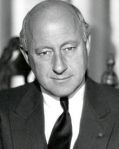The Movement.
March 29, 2011 3 Comments
“I can completely relate to this issue. I’ve been hobbling around campus in a knee brace for the past four weeks and I was surprised to find that many of the older buildings don’t provide any accommodation for handicapped students. I would have to walk up 30 stairs on my injured leg… not fun.” – Alix
Hey Chapman, how would you like to walk 30 stairs after having knee surgery? I applaud Alix for continuing to walk up those stairs. I probably would have just ditched those classes.
Some of you guys might be asking, “Why didn’t she go talk to Jason McAlexander, the Disabilities Specialist?” I don’t think this policy is known very well to students. I was completely oblivious to classroom changing prior to writing this blog. So I hope that by writing this blog, students will become more informed of Chapman’s policies and rather than hopping up stairs or walking on a bad knee, that you will be able to contact Jason and be accommodated- at least until elevators are installed in every building!
“Is there a particular reason for this topic? I want to see the passion behind this in your blog.” – Kaitlyn
Fortunately, I have never experienced inaccessibility at Chapman University due to a broken leg or wheelchair confinement.
However, after taking Sociology- Abuse of the Disabled during Interterm, I felt like this was something that needed to be addressed. I, too, was completely unaware of the struggles that some may face due to this. I believe that most Chapman students do not realize this issue because we are all fortunate to be able to use our legs. It is something that is most often taken for granted.
“Wow, I would have never even realized the lack of wheelchair access if you hadn’t made this blog.” – Molly
“This is a really important issue that absolutely needs to be brought to attention. It’s something that I’ve never thought about or noticed before, and I am anxious to see what comes of this!” – Sean
Unlike other students who may have had a family member not be able to see their rooms or their classrooms, I was never one of them. I’m a commuter so there was really no need to dorm as I live 15 minutes from Chapman and as a transfer, my parents never really saw the campus, except for Chapman’s Global Citizens Award- and that was even before I was a student! So no, there is no personal connection to the topic. However, I learned so much during my interterm class that I do believe that something must be done. Chapman University takes pride in diversity and in creating an personalized program for every student so I believe that we can go a step further.
Unfortunately, some of my classmates have experienced the frustration with loved ones not being able to access dorms or classrooms.
“My cousin has severe Cerebral palsy and when he visited Chapman it was so hard for him to see all of the building, including my dorm. There were few tables available for him to sit at and it was just a really draining experience for myself and my family.” – Dani
“My great aunt is in a wheel chair as well as on oxygen and was unable to visit my dorm room as well as several of the class rooms that I had classes in in the semester that she visited me in 2009. Very upsetting and uncomfortable for my whole family, as well as many many members of the Chapman community as well.” – Erin
“It’s true, many parts of our campus (especially around Memorial, Smith, Reeves and Roosevelt Hall) are inaccessible to people with wheelchairs, and considering we have been around for so long, you would think the school would find ways to accommodate every person’s needs.” – Amanda
“I think this is a great topic to discuss. Most people don’t seem to realize the lack of wheelchair accessibility at our school unless they are the ones in the wheel chair or using the crutches themselves. I think this blog will help open up the eye of all Chapman students and fuel them to help you with your change.” – Maddison
So how about it Chapman? Let’s get movement started!

 We’re a very reputable school and being the next generation, these sponsors should be targetting us. And what better way to make a generous donation? Of course it’s not easy task but I believe if we really put our minds and heart to it, it can be done. Chapman University has an exceptionally business school (named after George Argyros) and an amazing PRA program in the Dodge School of Media Arts (named after Kristina and Lawrence Dodge). I’m pretty sure that if we could get both schools together, we could create an amazing business plan, media/sponsorship kit as well as dedicated students to this cause to help secure a donor.
We’re a very reputable school and being the next generation, these sponsors should be targetting us. And what better way to make a generous donation? Of course it’s not easy task but I believe if we really put our minds and heart to it, it can be done. Chapman University has an exceptionally business school (named after George Argyros) and an amazing PRA program in the Dodge School of Media Arts (named after Kristina and Lawrence Dodge). I’m pretty sure that if we could get both schools together, we could create an amazing business plan, media/sponsorship kit as well as dedicated students to this cause to help secure a donor.

 In the article (found here) it says that the average price of this piece is about $30,000. President Doti got it for a price that is reduced from that, although the actual price was not told. As I was doing research online, the price to install an elevator is about $10,000- $30,000. Heck, I might be wrong but it’s what various sites have told me. Think about it folks. That money could have been spent on something useful. Again, don’t get me wrong. The sculpture is a pleasure to look at and I’m sure it has great meaning behind it but what can it provide for the students? Some have even complained that because of the awkward positioning of this statue, it interferes to accessing their classrooms.
In the article (found here) it says that the average price of this piece is about $30,000. President Doti got it for a price that is reduced from that, although the actual price was not told. As I was doing research online, the price to install an elevator is about $10,000- $30,000. Heck, I might be wrong but it’s what various sites have told me. Think about it folks. That money could have been spent on something useful. Again, don’t get me wrong. The sculpture is a pleasure to look at and I’m sure it has great meaning behind it but what can it provide for the students? Some have even complained that because of the awkward positioning of this statue, it interferes to accessing their classrooms.